Draft:List of Leopard 2 Variants
| Submission declined on 8 July 2024 by Twinkle1990 (talk). This submission is not adequately supported by reliable sources. Reliable sources are required so that information can be verified. If you need help with referencing, please see Referencing for beginners and Citing sources.
Where to get help
How to improve a draft
You can also browse Wikipedia:Featured articles and Wikipedia:Good articles to find examples of Wikipedia's best writing on topics similar to your proposed article. Improving your odds of a speedy review To improve your odds of a faster review, tag your draft with relevant WikiProject tags using the button below. This will let reviewers know a new draft has been submitted in their area of interest. For instance, if you wrote about a female astronomer, you would want to add the Biography, Astronomy, and Women scientists tags. Editor resources
|  |
 Comment: Most claims are unsourced. Twinkle1990 (talk) 08:40, 8 July 2024 (UTC)
Comment: Most claims are unsourced. Twinkle1990 (talk) 08:40, 8 July 2024 (UTC)
Leopard 2
[edit]The baseline Leopard 2, sometimes informally called the "A0" to differentiate it from later versions, was the first series manufactured version. The vehicles were manufactured from October 1979 until March 1982, altogether 380 vehicles. 209 were built by Krauss Maffei and 171 by MaK. The basic equipment consisted of electrical-hydraulic stabiliser WNA-H22, a fire control computer, a laser rangefinder, a wind sensor, a general-purpose telescope EMES 15, a panorama periscope PERI R17, the gunner's primary sight FERO Z18, on the turret roof as well as a computer-controlled tank testing set RPP 1–8. 200 of the vehicles had a low-light enhancer (PZB 200) instead of thermal imaging. Two chassis served as driver training vehicles.[citation needed]
Leopard 2A1
[edit]Minor modifications and the installation of the gunner's thermal sight[1] were worked into the second batch of 450 vehicles Leopard 2, designated the A1. Krauss-Maffei built 248 (Chassis Nr. 10211 to 10458) and MaK built 202 (Chassis Nr. 20173 to 20347). Deliveries of the 2A1 models started in March 1982 and ended in November 1983. The two most notable changes were the modification of the ammunition racks to be identical to those in the M1A1 Abrams, and redesigned fuel filters that reduce refuelling time.[citation needed]
A third batch of 300 Leopard 2, 165 by Krauss-Maffei (Chassis Nr. 10459 to 10623) and 135 by MaK (Chassis Nr. 20375 to 20509.), was built between November 1983 and November 1984. This batch included more minor changes that were later retrofitted to the earlier 2A1s.[citation needed]
Leopard 2A2
[edit]This designation was given to upgraded vehicles of the first batch of Leopard 2s, brought up to the standard of the second and third batches. This modernisation gradually replaced the original PZB 200 sights in the first batch with thermal sights for the EMES 15 as they became available. The upgrade included the fitting of filler openings and caps to the forward hull fuel tanks to allow separate refuelling. There was an addition of a deflector plate for the periscope and a large coverplate to protect the existing NBC protection system. The tank was given new five metre towing cables with a different position. The programme began in 1984 and ended in 1987. The third, fourth and fifth batches, which were produced during this period, had the same features. The modernised first batch can be recognised by the circular plate covering the hole where the crosswind sensor for the fire control system was removed.[2]
Leopard 2A3
[edit]The fourth batch of 300 vehicles, 165 by Krauss-Maffei (Chassis Nr. 10624 to 10788) and 135 by MaK (Chassis Nr. 20510 to 20644), was delivered between December 1984 and December 1985. The main change was the addition of the SEM80/90 digital radio sets (also being fitted to the Leopard 1 at the same time), and the ammunition reloading hatches being welded shut. Even with these minor changes the new batch was known as the 2A3.[citation needed]
Leopard 2A4
[edit]
The most widespread version of the Leopard 2 family, the 2A4 models included more substantial changes, including an automated fire and explosion suppression system, an all-digital fire control system able to handle new ammunition types, and an improved turret with flat titanium/tungsten armour. The Leopard 2s were manufactured in eight batches between 1985 and 1992. All the older models were upgraded to 2A4 standard. Until 1994, Germany operated a total of 2,125 2A4s (695 newly built and the rest modified older versions),[citation needed] while the Netherlands had an additional 445 tanks. The 2A4 was licensed and manufactured in Switzerland as the Panzer 87 "Leopard" or Pz 87. This version included Swiss-built 7.5 mm MG 87 machine guns and communications equipment and featured an improved NBC protection system. Switzerland operated 380 Pz 87 tanks.[citation needed]
After 2000, Germany and the Netherlands found themselves with large stocks of tanks that they had no need for after the Cold War. These tanks were sold to NATO or friendly armies around the world. Among these buyers of the surplus tanks were Turkey (purchasing 354 vehicles), Greece (183), Sweden (160), Chile (140), Finland (139), Poland (128), Austria (114), Spain (108), Canada (107), Indonesia (103), Singapore (96), Norway (52), Denmark (51), and Portugal (37).[3]

The Pz 87WE (WertErhaltung) is a planned Swiss modification and upgrade of the Pz 87.[4] The modification significantly improves protection through the addition of the Leopard 2A6M's mine protection kit, thicker armour on the front glacis, and a turret equipped with a Swiss-developed armour package using titanium alloy. The turret roof armour is improved and the smoke grenade launchers are redesigned. Further improvements enhance survivability and combat capabilities, such as a turret electric drive similar to the Leopard 2A5, a driver rearview camera, an independent weapons station for the loader, and enhanced command and control systems. The fire control system is upgraded, using the Carl Zeiss Optronics GmbH PERI-R17A2 fire control system. A remote weapons station containing a fully stabilised Mg 64 0.50 in (12.7 mm) machine gun is fitted to the tank.[citation needed]
The Swiss company RUAG offered an upgrade package for Pz 87 main battle tanks to meet a possible requirement of the Swiss Army for improved protection. It is fitted with a new modular composite armour package. Armour modules can be tailored to provide enhanced protection against a specific threat. Damaged modules can be easily replaced in field conditions. Upgraded tanks are less vulnerable to direct hits, anti-tank missiles, RPG rounds, mines, and IEDs. The vehicle received new sensors such as a sniper detection sensor and a laser warning receiver.[5][6] In 2021, the two prototypes with add-on armour were handed to the Militär- und Festungsmuseum Full-Reuenthal.[7]
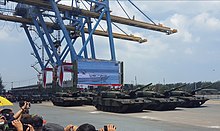
The Indonesian Army operates the Leopard 2 Republic Indonesia or Leopard 2RI, an upgraded variant based on Rheinmetall's MBT Revolution upgrade for the Leopard 2A4 tank. The upgrade includes AMAP armour from IBD Deisenroth and Rheinmetall Chempro, improved fire control systems, and battlefield management and situational awareness systems.[8][9]
The Pz 87–140[10] is an experimental variant of the Swiss Pz 87 with a 140 mm gun and additional armour, which was later used on the newer production variants.[citation needed]
The Leopard 2A4CHL is the upgraded Chilean version of the Leopard 2A4 ordered by Chile in 2007. Upgrades include new electronics, sighting, and information systems meant to elevate the Leopard 2A4's networking capability to be equal to that of the Leopard 2A6, a new suspension system, and the upgrading of the tank main gun to the L/55 smoothbore cannon used on the Leopard 2A6. Other upgrades are remote weapon stations over the gunner and commander hatches fitted with the MG3 and HK GMG. The Leopard 2A4CHL has improved roof and side turret armour and can be uplinked with Chile's battlefield control network.[citation needed]
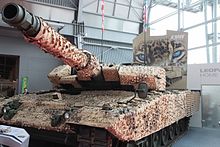
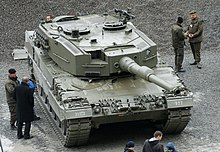
The Leopard 2A4M CAN is the upgraded Canadian version of the Leopard 2A4 acquired from the Royal Netherlands Army surplus. The Leopard 2A4M CAN is specially designed for the war in Afghanistan, based on experience gained by Leopard 2 operators. The first 20 were delivered in October 2010. Five were deployed to Afghanistan at the end of 2010 and operated until July 2011, when combat operations stopped.[11] Though originally planned to be up-gunned to the L/55 for consistency with the 2A6M CAN, the longer barrelled guns (optimised for tank-vs-tank warfare) were found to be less than ideal in Afghanistan, therefore it was decided to retain the L/44. Only small areas of slat armour were added, in contrast with the fully caged 2A6M CANs. The protection of the Leopard 2A4M CAN has been further augmented by the addition of applique armour resembling that found on the most recent Leopard 2A7+ variant, but modified to fit the turret configuration of the 2A4.[12] Of the 2A4s acquired, 11 were converted for training use (9 A4s, 2 A4Ms). In February 2011, Canada bought 12 2A4s/Pz 87 from Switzerland for the 'Force Mobility Enhancement' project which, along with the remaining unused ex-Dutch tanks, saw 18 converted to Armoured Engineering Vehicles and 4 converted to Armoured Recovery Vehicles.[13] Canada has also purchased 15 2A4s from Germany as Logistic Stock Vehicles (for spare parts).
The Leopard 2NG (Next Generation) is a privately funded Turkish upgrade by ASELSAN that includes the application of AMAP, upgraded optics, completely overhauled turret mechanics, and a new fire control system on the work since 1995 and to be delivered by late 2011, which is intended to be used on the new Altay MBT. It was developed without an order from the Turkish Army, but might meet the requirements for the modernization of the Turkish Leopard 2A4s.[14] The old powerpack and the L/44 gun barrel are kept, but the combat weight is increased to 65 tonnes.[14] According to Turkish news sources, Finland was interested in getting the Turkish upgrade package to modernise their fleet of Leopard 2A4s. However, in 2015 Finland purchased 120 2A6 vehicles from the Netherlands.[15][16]
The Leopard 2 hull was used for the Vickers Mk 7 main battle tank, which featured a British-designed turret, where some of the innovations later were incorporated into the Challenger 2 design.[citation needed]
In December 2015, Bumar-Labedy signed an agreement with German Rheinmetall Landsysteme Gmbh concerning the technological support of the Polish modernization program for Leopard 2A4 tanks. The company will design, document, and execute six prototypes. The first upgraded Leopard 2PLs have arrived in Poland in June 2020, with all 142 tanks to be delivered by 2023.[17] The upgrades include third generation night vision systems (production of the Warsaw PCO), new additional armour modules and anti-splash lining, removal of flammable components (turret drive system and main propulsion system), installation of the new fire protection system, modernization of the tank's integrated monitoring and testing equipment, the possibility of using new types of ammunition (programmable DM-11 and DM-63), and an auxiliary generator set (APU). Construction of all 142 units will be completed by the end of 2020.[citation needed]
Turkey is planning to modernize its Leopard 2A4 MBTs as Leopard 2A4TR with the T1 Modernization Package.[clarification needed] According to the Defense Industry Presidency, Leopard 2A4 tanks will be modernized with; Explosive Reactive Armour (ERA), T1 Reactive-Passive Armour, High Ballistic Strength Cage Armour, Hollow Modular Add-on Armour, Close Range Surveillance System (YAMGÖZ), Laser Warning Receiver System (LIAS), SARP Remote Controlled Weapon System (UKSS), PULAT Active Protection System (AKS), a new power distribution unit, ASELSAN Driver Surveillance System (ADİS) and voice alert system integrations. The modernization programme is to be completed in 2 batches. The programme will start with 84 Leopard 2A4 tanks in the first batch and the remaining tanks will be modernized within the 2nd batch. A total of 334 tanks (including prototypes) are planned to be upgraded with the T1 modernization programme. The new modernized Leopard 2A4 that was presented at the BMC factory was fitted with an Altay turret, which is armed with one 120 mm 55 caliber smoothbore gun designed and manufactured by the Turkish Company MKE, based on a technology transfer from Hyundai Rotem of South Korea. A remote-controlled weapon station is mounted on the top of the turret which is armed with a 12.7mm caliber heavy machine gun.[18][19][20][21][22][23]
Leopard 2A4V
[edit]On 1 September 2023, video on social media showed Ukrainian crews with 30 Leopard 2A4 upgraded with Kontakt ERA and T-80U style rubber screens, denoted Leopard 2A4V.[24] This followed previous sightings in Ukraine of a Canadian supplied Leopard 2A4 upgraded with Kontakt-1 ERA.[25][26]
Leopard 2 Marksman
[edit]
Finland has modernised its Marksman SPAAG vehicles by replacing the original T-55AM chassis with a newer Leopard 2A4 chassis.[27] The upgraded Marksman vehicles were scheduled to enter service with the Finnish Army in 2016.[28] The new Leopard 2 chassis greatly improves mobility compared to the older T-55AM chassis, both on- and off-road. The Leopard 2 chassis is larger, providing a more stable firing platform for the Marksman turret to operate from.[29]
Leopard 2 Imp
[edit]
"Leopard 2 Improved" was a series of three prototypes used to test possible further enhancements beyond the Leopard 2A4 model, developed beginning in 1988.[30] After a concept phase, a component test bed (KVT, Komponentenversuchsträger) was built in 1989, followed by two troop trial vehicles (TVM, Truppenversuchsmuster). The Leopard 2 Improved was mostly focused on improving armour protection, introducing the wedge-shaped, spaced add-on armour at the turret front, as well as hull and roof add-on armour, greatly improving protection against hollow charge and kinetic energy threats. It does not form a shot-trap, since it does not deflect the penetrators outwards to hit the hull or turret ring. The gun mantlet was redesigned to accept the new armour.[31] Aside of improved armour protection, these tanks also included improved optics, navigation systems and electronics.
Following the initial trials of the two TVM protoypes in Germany and an agreement of the Leopard 2 user states, the second TVM prototype was modified (becoming the TVM 2 mod.) by removing several parts such as the add-on hull and roof armour,[32] becoming the basis for the Leopard 2A5 model. One Leopard 2 Improved (TVM 2) competed in Sweden against the Leclerc and M1A2 Abrams, leading to the adoption of the Stridsvagn 122.
Leopard 2A5
[edit]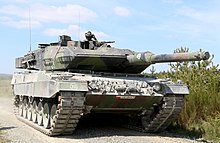
The Leopard 2 Improved was developed into the Leopard 2A5. Most of its improvements were focused on armour protection; it was enhanced by adding external add-on modules to the turret and replacing the turret's internal armour modules with ones of newer, improved composition.[33] The interior received spall liners to reduce fragments if the armour is penetrated.[33] The commander's sight was moved to a new position behind the hatch and it received an independent thermal channel. The gunner's sight was moved to the turret roof as opposed to the cavity in the front armour in previous models. A heavier sliding driver's hatch was fitted.[34]
The hydraulic turret drives were replaced by an all-electric system, increasing reliability and crew safety, as well as weight savings.[33] The gun braking system was improved to prepare for the later mounting of the new L/55 gun tube and to enable firing of more powerful ammunition, such as the DM53 APFSDS. The first A5s were handed over to the German army tank school in 1995 and started to enter regular service with Panzerbataillon 33 in December the same year.[34]
The Leopard 2A5 DK is a variant of the Leopard 2A5 similar to the Leopard 2A6 with some small modifications, used by the Danish Army.[35]
Stridsvagn 122
[edit]
Stridsvagn 122 (also known as Leopard 2A5S[36] and Leopard 2 "Improved" A5 SE[37] ) is a Swedish Army tank based on the Leopard 2 Improved. 120 units were built, 91 of which were licence-produced in Sweden. The tank features increased armour on the turret top and front hull, and improved command-, control- and fire-control systems. Externally, it can be distinguished from the Leopard 2A5 by the French GALIX smoke dispensers, different storage bins, and the much thicker crew hatches.[31] The Strv 122B+ Evolution, a variant equipped with modular AMAP composite armour from IBD Deisenroth, has increased 360° protection against threats like EFPs, RPGs and IEDs.[38] The width of 4 metres (13 ft) has been kept, while the weight increases by only 350 kilograms (770 lb).[38]
Leopard 2-140
[edit]In the early 1990s,[citation needed] Rheinmetall began development of a 140 mm smoothbore cannon for use in future tank designs. The new gun was intended to counter new Soviet tank developments, especially since the next generation of Soviet main battle tanks were rumoured to be armed with a 135 mm or 152 mm cannon. The new 140 mm cannon was part of a modernisation programme for the Leopard 2 known as the KWS III.[39][unreliable source?] Test firing of the new 140 mm cannon was conducted. Results showed that the gun had high penetration values, and had a muzzle velocity of around 2,000 metres a second, with potential to be increased further. However, the 140 mm rounds were too heavy for the tank crew to handle effectively.[citation needed]
The KWS III upgrade was to feature a new turret. This new turret was equipped with the planned 140 mm cannon and an autoloader. The introduction of an autoloader reduced the tank's crew to three members, as a dedicated loader was no longer needed. The gun's 32 rounds of ammunition were stored separate from the crew in a large compartment occupying the entire rear of the turret, in order to increase crew survivability in the event of a cook off. The turntable-style turret had the gun offset to the left side, due to the autoloader's lateral feeding of ammunition into the cannon breech.[citation needed] The turret was powered by an electro-hydraulic drive and featured an IFIS battlefield management system. The crew was protected by an armoured capsule and ballistic protection for the hull was to be improved. The planned protection level of the KWS III upgrade was to be equal to or better than the Leopard 2A5.[40][39][unreliable source?]
A total of 650 Leopard 2 KWS III tanks were originally projected to be purchased.ref name="Hilmes KPz HuM 70">Hilmes, Rolf (30 November 2007). Kampfpanzer heute und morgen: Konzepte – Systeme – Technologien (in German). Germany: Motorbuch Verlag. p. 70. ISBN 978-3613027930.</ref> However, in 1995, the KWS III programme was cancelled due to changes in the political environment.[clarification needed]
Despite this, development continued on the 140 mm cannon,[citation needed] with Rheinmetall coordinating with the British Royal Ordnance and French GIAT companies.[citation needed] The 140 mm cannon was fitted to an old Leopard 2 prototype with the turret T19.[41] Counterweights were added to the rear of the turret to balance the increased weight of the 140 mm cannon. The modified Leopard 2 was not equipped with any other KWS III upgrades apart from the new gun. Live fire testing showed mixed results, where the 140 mm cannon showed superior penetrating power compared to the existing 120 mm cannon, but demonstrated poorer handling characteristics.[39][unreliable source?] The lack of the autoloader on the prototype further hampered performance.[39][unreliable source?]
Leopard 2A6
[edit]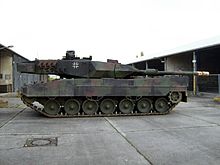
The Leopard 2A6 includes the addition of the Rheinmetall 120 mm L/55 smoothbore gun and other changes. All German tank battalions of the "crisis intervention forces" are equipped with the A6. Canada purchased twenty Leopard 2A6s from the Netherlands. These were delivered in 2007.[42] Portugal purchased 37 Leopard 2A6s from the Dutch in 2007, with delivery in 2008. In January 2014, Finland purchased 100 L2A6s, as well as munitions, simulators, and a ten-year supply of reserve parts from the Netherlands. The tanks were delivered in batches between 2015 and 2019.[43]
The Leopard 2A6A1 is a command version of the Leopard 2A6, stemming from the KWS I programme. The vehicle includes additional radios (with the amount depending on the level of command) to accommodate the communications for section, platoon, troop, company, squadron or battalion commanders.[44] For section leaders, the vehicle is fitted with 1x SEM 80 and 1x SEM 90 VHF radios. For platoon or troop commanders, the vehicle is fitted with 1x SEM 80 and 1x SEM 90 VHF radios along with an 800m field telephone cable drum fitted at the rear of the vehicle. For company, squadron or battalion commanders the vehicle is fitted with 2x SEM 80 or 1x SEM 93 and 1x SEM 90 VHF radios along with an 800m field telephone cable drum, for either fitted at the rear of the vehicle.[44]

The Leopard 2A6M is a version of the 2A6 with enhanced mine protection under the chassis, and internal enhancements to improve crew survivability.[45] In the summer of 2007, Canada borrowed 20 A6Ms from Germany for deployment to Afghanistan.
The Leopard 2 Hel ("Hellenic") is a derivative of the 2A6 that was ordered by the Greek Army in 2003. The 170 tanks were delivered between 2006 and 2009. A total of 140 were built in Greece by ELBO, which delivered the first units in late 2006.[46]
The Leopard 2A6M CAN is a Canadian variant of the Leopard 2A6M. Significant modifications include distinctive black boxes mounted on the rear of the turret bustle,[47] and stand-off slat armour.[48] The first tanks configured in this variant were 20 loaned from the German Bundeswehr in an effort to increase firepower and protection given to Canadian troops operating in the south of Afghanistan. The loaned tanks retain their German MG3 machine guns, the ex-Dutch tanks are also expected to retain their FN MAG machine guns due to commonality with Canadian stocks of C6 GPMG, itself a variant of the FN MAG.[49]
Due to the loaned status of the first twenty tanks, the air conditioning unit originally could not be installed, as only minimal changes could be made. The crew wore cooling vests instead, and the turret's electric drive generates less heat than the hydraulic drive of the older Leopard C2. The loaned German tanks will be kept by the Canadian Forces and may be further upgraded, while ex-Dutch Leopard 2A6s were modified to German Leopard 2A6M specifications and used as restitution for the loaned tanks.[50] Canadian Leopard 2s in Afghanistan were later fitted with air conditioning units, a much-needed commodity in the scorching desert of Afghanistan, and Saab's Barracuda camouflage mats, which reduce solar loading by 50 percent.[51]
The Leopard 2A6TR was the Turkish variant during the Turkish Army tank procurement project in 2000. The version was based on 2A6EX. The project was dropped in favor of developing the indigenous Altay (main battle tank).[52]
Leopardo 2E
[edit]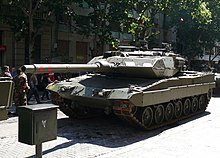
The Leopard 2E is a derivative of the 2A6, with greater armour protection,[53] developed under a programme of co-production between the defence industries of Spain and Germany. The programme was developed within the frame of collaboration decided in 1995 between the Defence Ministries of both countries, which also included the cession of use by period of five years of 108 Leopard 2A4 from the German Army to the Spanish Army. The session was extended up to 2016, and after that those tanks will be the sole property of the Spanish Army, as has been made public in January 2006, then having been paid a total of €15,124,014 in ten yearly installments, giving the Spanish co-ownership from 2006.
In 1998, the Spanish government agreed to locally build 219 tanks of the Leopard 2E line, 16 recovery tanks of Leopard 2ER (Buffalo), and 4 training vehicles. They chose Santa Bárbara Sistemas as the main contractor. The programme, with a budget of €1,939.4 million, includes integrated logistical support, training courses for crew instructors and maintenance engineers, and driving, turret, maintenance, aiming, and shooting simulators. Deliveries of the first batch began in 2004.[citation needed]
Leopard 2PL
[edit]
The Leopard 2PL is a Polish modernized version of the Leopard 2A4, carried out in cooperation with Rheinmetall and the Polish Armaments Group (Polish: Polska Grupa Zbrojeniowa, PGZ). The Leopard 2PL MBT is primarily tasked with assault, maintaining territory, and supporting mechanized and motorized subdivisions with its onboard weapon systems in all weather conditions during the day and night. The main upgrades when compared to the Leopard 2A4 include modernization of the commander's and gunner's sight, additional ballistic modules on the turret, replacement of the hydraulic stabilization system with a new electric system, and new fire extinguishing and fire suppression systems.[54][55]
The upgrade included a new commander's control and monitoring system, the installation of an auxiliary power unit (APU), a new turret stowage compartment for crew equipment, the modernization of its main gun to use new types of programmable ammunition, and the integration of day/night rear camera for drivers. Included are customized towing vehicles due to the increased weight of the upgraded tank.[54][55] The upgraded 2PL version is in service with the Polish Land Forces. Of the Leopard 2A4s from the first (128) and the second (14) batches, 24 have been upgraded to Leopard 2PL standard.[56] The rest will be upgraded to the 2PLM1 standard.[57]
Leopard 2 PSO
[edit]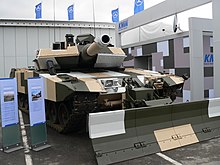
The new Leopard 2 PSO (Peace Support Operations) variant is designed especially for urban warfare, which had been encountered in peacekeeping operations with increasing frequency. The Leopard 2 PSO is equipped with more effective all-around protection, a secondary weapons station, improved reconnaissance ability, an obstacle clearance blade (OCB), a shorter gun barrel for manoeuvring on urban streets at the expense of fire range, non-lethal armament, close-range surveillance ability through camera systems, a searchlight and further changes to improve its perseverance and mobility in built-up non-wide open areas. These features are similar to the Tank Urban Survival Kit for the American M1A2 Abrams.[citation needed]
Leopard 2A7
[edit]The Leopard 2A7 vehicle is not intended to be optimized for combat in urban terrain, thus it is fundamentally different from the KMW variant, the: 2A7+ (see below). A total of 20 vehicles were provided for converting. It involves former Dutch A6NL models returned by Canada to Germany. The original upgrade to A6M has been extended in coordination with Canada and includes a crew-compartment cooling-system from the Leopard 2 A6M-HEL series, a new 20 kW auxiliary power unit based on the Steyr Motors M12 TCA UI engine,[58] the Saab Barracuda Mobile Camouflage System (MCS) with Heat-Transfer Reduction (HTR CoolCam) system,[59] a field trial proven combat management and information system (IFIS: Integriertes Führungs- und Informationssystem), onboard network optimization with ultracapacitors in the chassis and turret, a SOTAS IP digital intercom system, a renewal of the fire suppression system in the crew compartment, and the retrofitting of Attica thermal imaging module in the commander optics.[60]
The weapon system is adapted for firing HE ammunition. It is fitted for, but not with, additional passive side protection armour. The first Leopard 2A7 was handed over to the German Army in Munich in December 2014. 14 vehicles were produced for Tank Battalion 203, 4 went to the Armoured Corps Training Centre and one vehicle went to the Technical School for Land Systems and School for Technology of the Army. The last tank remains as a reference vehicle at KMW.[60]
The Danish Armed Forces received its first Leopard 2A7 main battle tanks upgraded in Germany from the Leopard 2A5DK version at the Dragoon Barracks in Holstebro. The Danish Army will receive a total of 44 Leopard 2A7 vehicles by 2022.[61]
Siemon T. Wezeman, senior researcher at SIPRI's arms transfers and military expenditure programme, stated that information from the UN Register of Conventional Arms 2016, indicated that some Leopard 2A7s were transferred to Singapore after 2014. SIPRI reported that the Singapore Army probably acquired a total of 45 Leopard 2A7s between 2016 and 2019, but the Singapore's Ministry of Defence denied having acquired the 2A7 version, presumably to minimise anxiety among her neighbors.[62][63][64]
In February 2023, Norway ordered 54 Leopard 2A7 tanks to be delivered from 2026, with a further option for 18 vehicles if necessary.[65] This order was later changed into a newly specified 2A8 NOR subvariant of the 2A8.
Leopard 2A7+
[edit]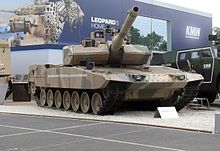
The Leopard 2A7+ was first shown to the public during the Eurosatory 2010, featuring the label "Developed by KMW – tested and qualified by the German Ministry of Defence". The Leopard 2A7+ has been tested by the Bundeswehr under the name UrbOp (urban operations).[citation needed]
The Leopard 2A7+ is designed to operate both in low-intensity and high-intensity conflicts.[66] The tank's protection has been increased by modular armour. The frontal protection has been improved with a dual kit on the turret and hull front, while 360° protection against RPGs and mine protection increase the survivability of the tank in urban operations.[66] The modular armour's system components were first used by Canada in Afghanistan.[67] It can fire programmable High Explosive munitions. The turret-mounted MG3 has been replaced with a stabilised FLW 200 remotely controlled weapon station. Mobility, sustainability, and situational awareness have also been improved.[66]
In December 2018, Hungary ordered 44 2A7+s (renamed 2A7HU), making them the second operator of the improved version, after Qatar.[68][69]
Leopard 2A8
[edit]To replace the 18 Leopard 2A6 tanks handed over to the Armed Forces of Ukraine, the German Ministry of Defence plans to purchase a batch of 18 Leopard 2A8 tanks (with the option to 105 further).[70] Germany has offered to integrate orders from Allies into this contractual framework.
Italian government confirmed during a Parliament audition that Italy intends to purchase up to 250 Leopard 2A8 tanks over 2023–2025 period.[71]
The Leopard 2A8 will be based on the current Leopard 2A7HU production model but feature additional improvements; among them the integration of the Trophy APS and an all-round situational awareness system with sensor-fusion capability.[70]
The Dutch MoD is planning on procuring up to 52 Leopard 2A8 tanks in addition to their 18 leased Leopard 2A6 tanks.[72] This planned acquisition is part of the nation's effort to rebuild their army after severe budget cuts of the 21st century.
As part of the ongoing modernisation and expansion of their Army Lithuania plans to acquire Leopard 2A8s and associated support vehicles from Germany to equip a Tank Battalion.[73]
The Czech Ministry of Defense is negotiating with Germany the purchase of 70–77 Leopard 2A8, including domestic manufacturing rights for aspects of the tank production.[74][75]
Leopard 2A8 NOR
[edit]The Norwegian armed forces' order of 54 Leopard 2A7NOs was changed into a new 2A8 NOR variant by the middle of June 2023. A variety of Norwegian changes and alterations necessitated the renaming of the original 2A7NO into a unique new 2A8 NOR variant. This subvariant mainly differs from the German 2A8 by integrating a Norwegian-designed C4IS-solution that includes Kongsberg's ICS/CORTEX-solution and Teleplan Globe's FACNAV/norBMS battlefield management system.[76]
References
[edit]- ^ Gelbart, Marsh (1996). Tanks: main battle and light tanks. Brassey's UK Ltd. pp. 109–110. ISBN 978-1-85753-168-8. OCLC 36171829.
- ^ Jerchel, Michael; Schnellbacher, Uwe (1998). Leopard 2 Main Battle Tank 1979–1998. New York, United States of America: Osprey. pp. 17–18. ISBN 978-1-85532-691-0.
- ^ "Sipri: Trade Registers". sipri.org. Archived from the original on 23 April 2014. Retrieved 1 April 2015.
- ^ Liess, Stefan (22 July 2007). "Leopard 2". Kampfpanzer.de. Archived from the original on 20 April 2008. Retrieved 20 April 2008.
- ^ ARG. "RUAG Leopard 2 Upgrade Main Battle Tank". Military-Today.com. Retrieved 24 June 2022.
- ^ "RUAG introduces a new Leopard 2 A4 armor upgrade at IAV 2013 International Armoured Vehicles | IAV 2013 News coverage report pictures video | Defence and security military exhibition 2013". Armyrecognition.com. 6 February 2013. Retrieved 24 June 2022.
- ^ "Zwei Schweizer Prototypen des Kampfpanzers Leopard 2". Militär- und Festungsmuseum Full-Reuenthal. Retrieved 5 April 2023.
- ^ "Leopard 2A4 tanks for Indonesia will be fitted with the Revolution urban warfare package". armyrecognition.com. 25 May 2016. Archived from the original on 30 November 2022. Retrieved 20 April 2022.
- ^ ARG. "Revolution Main Battle Tank". Military-Today.com. Retrieved 24 June 2022.
- ^ "Pz 87–140 image". Archived from the original on 29 November 2014. Retrieved 15 November 2014.
- ^ "Tanks for the Lesson: Leopards, too, for Canada". Archived from the original on 21 June 2008. Retrieved 12 October 2010.
- ^ "Background — Canadian Forces Upgraded Leopard 2A4M Tanks". Canadian-American Strategic Review. February 2011. Archived from the original on 1 April 2011. Retrieved 19 March 2011.
- ^ "Force mobility enhancement". 13 December 2018. Retrieved 27 November 2020.
- ^ a b Foss, Christopher. "Upgraded Leopard 2 MBT set for firing trials". Jane's Information Group. Archived from the original on 14 September 2012. Retrieved 5 June 2011.
- ^ "Bakanın ağzından savunma ihalelerinde rüşvet kuşkusu". Radikal. 9 November 2010. Retrieved 28 December 2010.
- ^ Bakanın ağzından savunma ihalelerinde rüşvet kuşkusu (30 November 2009). "Savunma İhalelerinde Rüşvet Skandalı 09 Kasım 2010 17:08". Aktifhaber.com. Archived from the original on 11 November 2010. Retrieved 28 December 2010.
- ^ "Armoured breakthrough". 28 May 2020.
- ^ "BMC to modernize 84 Leopard 2A4s". savunmasanayist.com (in Turkish). 7 February 2021. Retrieved 7 February 2021.
- ^ "Quiet Modernisation for Turkish Leopard 2 Tanks". c4defence.com. Archived from the original on 28 October 2020.
- ^ "Turkish Army to Receive Leopard 2A4 with Roketsan T1 Reactive-Passive Armor". 18 September 2020.
- ^ "IDEF 2021: BMC proposes upgrade for Turkish army Leopard 2A4 MBT | IDEF 2021 News Official Online Show Daily Media Partner | Defence security exhibitions 2021 show daily news category | Defense & Security Exhibitions Archives". Armyrecognition.com. 18 August 2021. Retrieved 24 June 2022.
- ^ weapons defence industry military technology UK (26 January 2021). "Turkey unveils new Leopard 2A4 main battle tank upgrade fitted with Altay tank turret | weapons defence industry military technology UK | analysis focus army defence military industry army". Armyrecognition.com. Retrieved 24 June 2022.
- ^ "Leopard 2A4 Modernizasyonu Yeni Gelişmeler". SavunmaSanayiST. 23 January 2020. Retrieved 24 June 2022.
- ^ Axe, David (2023-09-02). "30 Ukrainian Leopard 2A4 Tanks Assembled In One Field—A Reminder That Ukraine Still Has Most Of Its Leopard 2s". forbes.com. Retrieved 2023-09-02.
- ^ Suciu, Peter (2023-07-02). "Video Of 'Leopard 2A4U' Main Battle Tank In Ukraine Went Viral – Did It Reveal Too Much?". forbes.com. Retrieved 2023-09-02.
- ^ Malyasov, Dylan (2023-07-01). "Ukrainian soldiers adding extra protection to their Leopard 2 tanks". defence-blog.com. Retrieved 2023-09-02.
- ^ Huhtanen, Jarmo (25 March 2015). "Armeija ottaa vanhojen Marksman-vaunujen tykkitornit uuteen käyttöön". hs.fi. Helsingin Sanomat. Archived from the original on 19 April 2017. Retrieved 25 March 2015.
- ^ "MAAVOIMIEN LIIKKUVUUDEN JA TULIVOIMAN ROLL OUT PANSSARIPRIKAATISSA 5.8.2015 – Esiteltävä kalusto" (PDF) (in Finnish). Finnish Defence Forces. 5 August 2015. Archived from the original (PDF) on 5 October 2015. Retrieved 2 December 2017.
- ^ "Marksman". weaponsystems.net. Archived from the original on 12 January 2017. Retrieved 2 December 2017.
The Leopard 2 chassis also provides a much increased mobility over the older T-55AM chassis, both on roads and in the field.
- ^ Scheibert (1996), p. 3.
- ^ a b Swedish Defence Materiel Administration: Leopard 2 – Stridsvagn 122 (Swedish)
- ^ Scheibert (1996), p. 4
- ^ a b c Scheibert (1996), p. 6
- ^ a b Michael Jerchel, Schnellbacher: "Leopard 2 Main Battle Tank 1979–98", Osprey Publishing, 1998, ISBN 9781782006954, section "The Improved Leopard 2"
- ^ "Kampvogne". forsvaret.dk (in Danish). Archived from the original on 12 June 2018. Retrieved 7 June 2018.
- ^ Rickard O. Lindström. "The Swedish Armoured Fighting Vehicle programmes: "Getting the most from protected platforms as weapon systems"" (PDF). Archived from the original (PDF) on 7 August 2016. Retrieved 16 October 2023.
- ^ Rickard O. Lindström. "Stridsfordon: Utveckling och anskaffning i Sverige – Arsenalen den 18 september Rickard O. Lindström" (PDF). Archived from the original (PDF) on 1 April 2016. Retrieved 16 October 2023.
- ^ a b "New MBT122B Evolution with Unprecedented Protection" (PDF). IBD Deisenroth Engineering. Archived from the original (PDF) on 8 October 2011. Retrieved 28 December 2010.
- ^ a b c d David.B (31 May 2015). "Krauss-Maffei Wegmann Leopard 2 (1978)". tanks-encyclopedia.com. Archived from the original on 2 November 2017. Retrieved 12 November 2017.[self-published source]
- ^ Hilmes, Rolf (30 November 2007). Kampfpanzer heute und morgen: Konzepte – Systeme – Technologien (in German). Germany: Motorbuch Verlag. p. 68. ISBN 978-3613027930.
- ^ Hilmes, Rolf (30 November 2007). Kampfpanzer heute und morgen: Konzepte – Systeme – Technologien (in German). Germany: Motorbuch Verlag. p. 230. ISBN 978-3613027930.
- ^ "Backgrounder: Renewing the Canadian Armed Forces' Tank Capability". DND/CF. Archived from the original on 9 June 2011. Retrieved 10 January 2008.
- ^ "Finland in 200 million-euro used tank deal with the Netherlands". Yle. 16 January 2014. Archived from the original on 16 January 2014. Retrieved 16 January 2014.
- ^ a b Janes Land Warfare Platforms: Armoured Fighting Vehicles – Tracked 2020–2021. Jane's Information Group. 2020. p. 99. ISBN 9780710633446.
- ^ Foss, Christopher F (8 August 2007). "Canada receives first upgraded Leopard 2A6M MBT". Jane's Defence Weekly. 44 (32): 10. ISSN 0265-3818. OCLC 210556835. BL Shelfmark 4646.840000.
- ^ "Leopard 2 HEL images and info". Archived from the original on 16 May 2008. Retrieved 6 July 2008.
- ^ "The First of Twenty Loaned Leopard 2A6M CAN Arrive in Kandahar: A Glimpse of the CF's Future (With a Little Help From Our Friends)". Canadian American Strategic Review. Archived from the original on 18 April 2008. Retrieved 6 July 2008.
- ^ "CASR Background — CF Leased & Purchased Leopard 2 A6M / 2 A4 Tanks". Archived from the original on 16 April 2008. Retrieved 6 July 2008.
- ^ "CASR Background — Leopard 2 A6M / 2 A4 Tanks for the Canadian Forces?". Canadian American Strategic Review. Archived from the original on 16 April 2008. Retrieved 6 July 2008.
- ^ "Letter of Interest: Tank Replacement Project". MERX Website – Government of Canada. 19 March 2008. Archived from the original on 9 June 2008. Retrieved 20 April 2008.
- ^ "Canadian Forces Armour — Leopard 2A6M CAN Main Battle Tank". Canadian American Strategic Review. Archived from the original on 27 June 2010. Retrieved 11 May 2010.
- ^ "Tank 2000'den ALTAY'a Türkiye'nin tank serüveni". 18 February 2020.
- ^ Candil, Antonio (1 February 2007). "The Spanish Leopard 2E: A Magnificent Tool". Military Technology. Mönch Editorial Group, p. 66.
- ^ a b "Breakthrough. Polish Army Takes Delivery of Leopard 2PL Tanks - Defence24.com". defence24.com. 29 May 2020. Retrieved 9 July 2020.
- ^ a b "Bumar Leopard 2PL MBT". bumar.gliwice.pl (in Polish). Retrieved 9 July 2020.
- ^ "Pierwsze Leopardy 2PL już w Polsce". Polska-zbrojna.pl. Archived from the original on 24 June 2019. Retrieved 17 January 2020.
- ^ pisze, Patriota (9 September 2020). "Wojsko Polskie prezentuje zmodernizowane czołgi". Wydawnictwo militarne ZBIAM.
- ^ "The LEOPARD 2 A7V" (PDF). Krauss-Maffei Wegmann GmbH & Co. KG. Archived (PDF) from the original on 20 November 2016. Retrieved 20 November 2016.
- ^ "MCS Mobile Camouflage System". Saab Solutions. Archived from the original on 20 November 2016. Retrieved 20 November 2016.
- ^ a b "Germany receives first Leopard 2A7 MBT". IHS Jane's Defence Weekly. Archived from the original on 1 May 2015. Retrieved 22 December 2014.
- ^ [1] Royal Danish Army Receives First Leopard 2A7V Main Battle Tank.
- ^ Yeo, Mike (25 February 2019). "German documents reveal Singapore received more Leopard 2 tanks". Defense News. Retrieved 6 August 2021.
- ^ Yeo, Mike (20 March 2018). "Singapore denies acquisition of new Leopard tank variant". Defense News. Retrieved 6 August 2021.
- ^ "Singapore allegedly acquires Leopard 2A7 tanks – Shephard Media". www.shephardmedia.com. Retrieved 6 August 2021.
- ^ "Tyske Leopard 2A7 blir Norges nye stridsvogn" (in Norwegian). TV2. 3 February 2023. Retrieved 3 February 2023.
- ^ a b c KMW Press release Archived 27 June 2010 at the Wayback Machine about the Leopard 2A7 +.
- ^ "Product Information – KMW". www.kmweg.com. Archived from the original on 16 May 2017. Retrieved 8 March 2017.
- ^ Braatz, Kurt (19 December 2018). "Krauss-Maffei Wegmann unterstützt ungarische Heeres-Modernisierung" (PDF). Krauss-Maffei Wegmann (in German). Munich. Archived from the original (PDF) on 20 December 2018. Retrieved 22 December 2018.
- ^ Dunai, Peter (20 December 2018). "Update: Hungary orders Leopard 2 MBTs and PzH 2000 SPHs". IHS Jane's 360. Budapest. Archived from the original on 21 December 2018. Retrieved 22 December 2018.
- ^ a b Heiming, Gerhard (25 May 2023). "Rahmenvertrag für bis zu 128 Leopard 2A8 unterschrieben". Europäische Sicherheit & Technik. Mittler Report Verlag GmbH. Retrieved 23 January 2024.
- ^ "XIX Legislatura – Lavori – Resoconti delle Giunte e Commissioni". Italian Parliament website. 12 July 2023.
- ^ "High on Defence: Listing Dutch Arms Acquisitions".
- ^ "Lithuania seeks to buy Leopard 2 tanks from Germany". Reuters. 23 January 2024.
- ^ Defense News (24 May 2023). "Panzer bonanza: Czech Republic joins Berlin's Leopard upgrade push".
- ^ Defense Aerospace (24 July 2023). "Minister Černochová: We Perceive the Biggest Threats of the Present in the Same Way as Germany".
- ^ "Norges nye stridsvogner blir Leopard 2A8 med israeldsignet aktiv beskyttelse" (in Norwegian). TU.no. 17 June 2023. Retrieved 17 June 2023.

- in-depth (not just passing mentions about the subject)
- reliable
- secondary
- independent of the subject
Make sure you add references that meet these criteria before resubmitting. Learn about mistakes to avoid when addressing this issue. If no additional references exist, the subject is not suitable for Wikipedia.